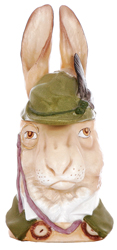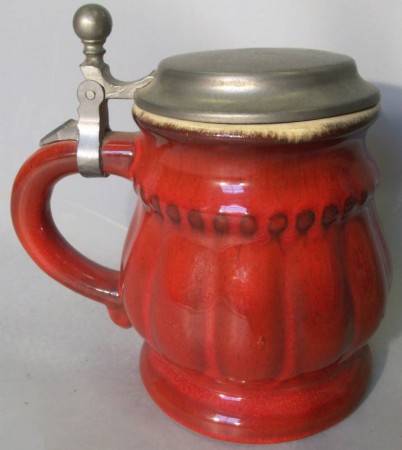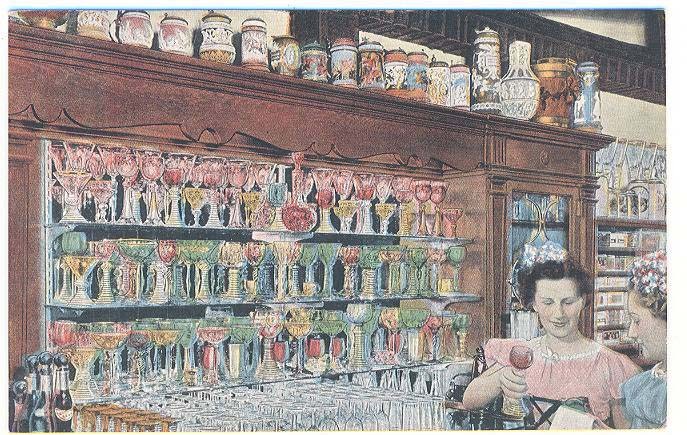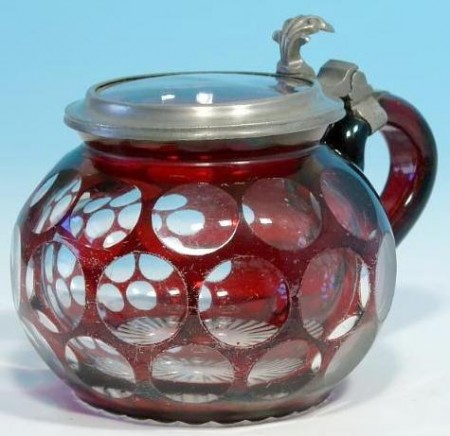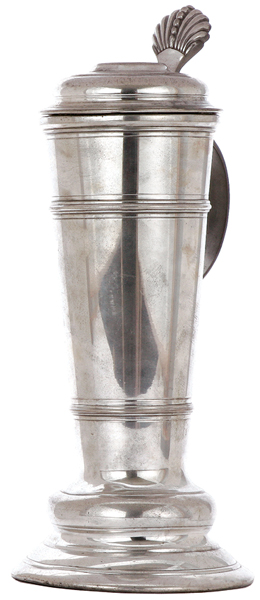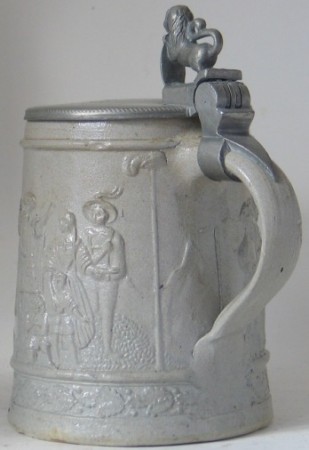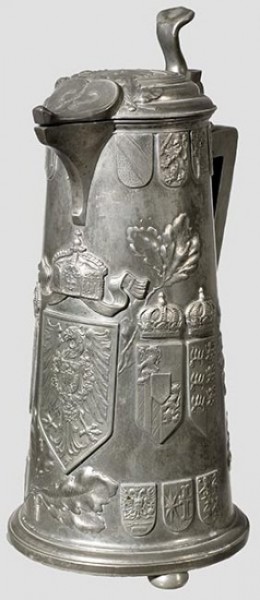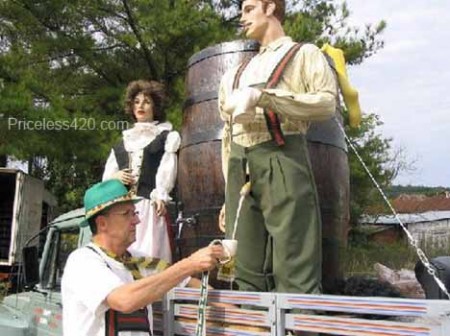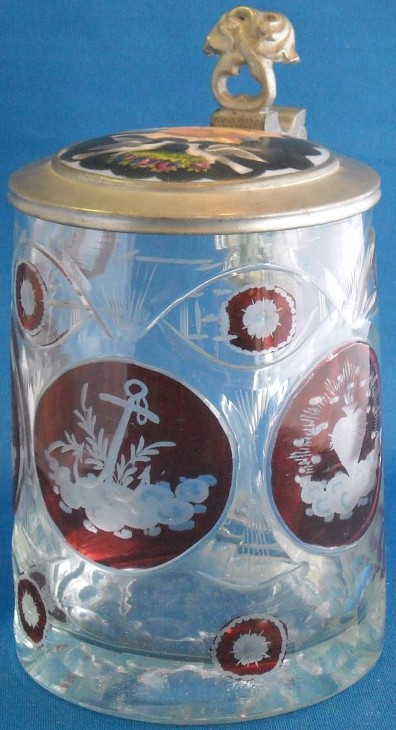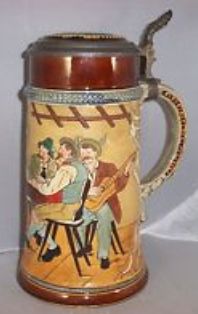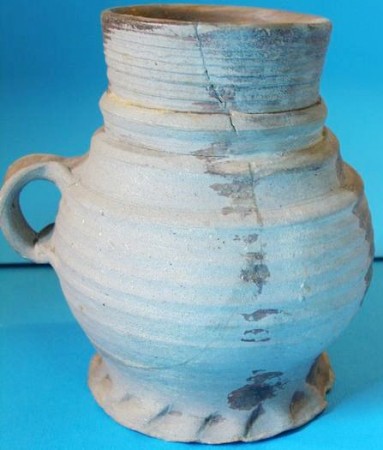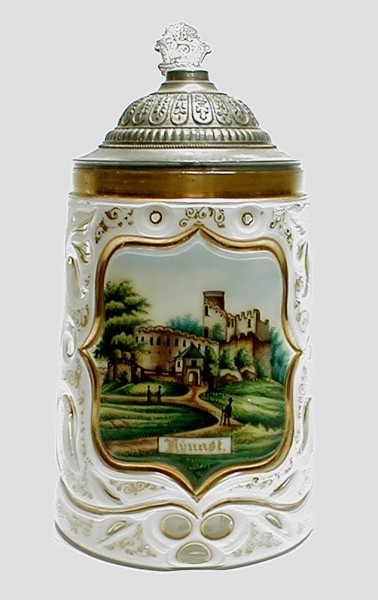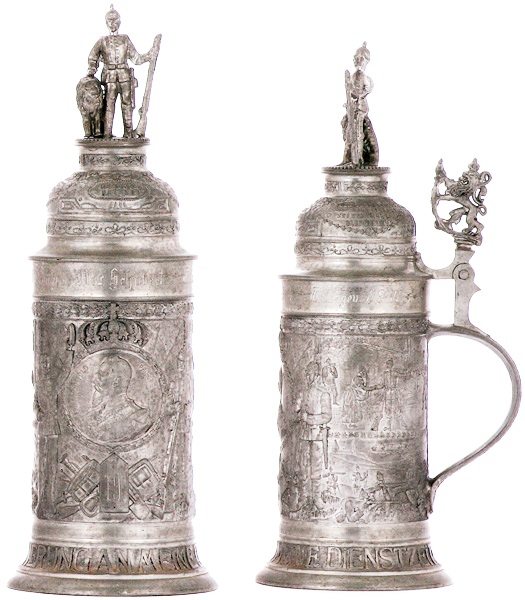
A Roemer used as a beer glass; unless he is drinking one of each?
Rabbits – Another very popular animal shown on steins, caused by the German food and hunting interests. Shown: A very popular and expensive porcelain character stein was made by Schierholtz, marked “Musterschutz.”
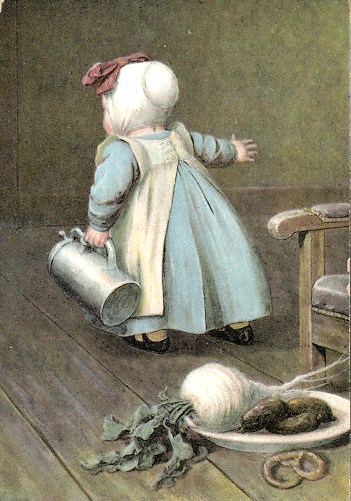
.
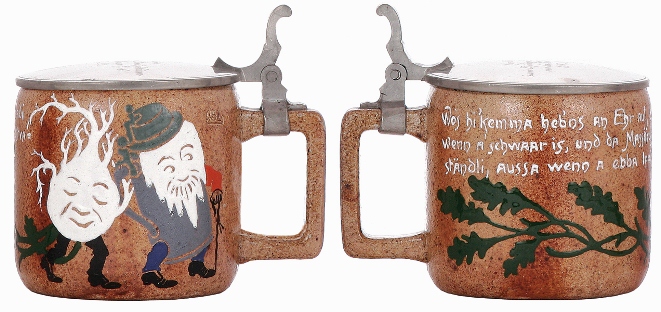
Radish – A favorite German snack with beer. The Germans made several character beer steins of radishes. [tsaco]
.
This painting and its variants have been used by all sorts of Breweries over the years.
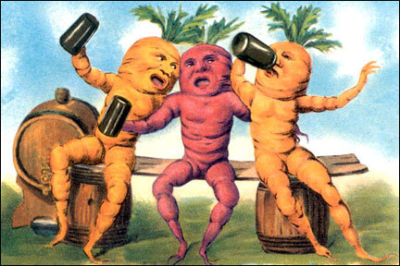
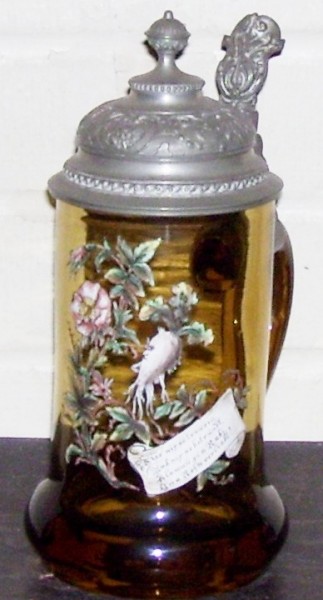
Radish – Shown: An enameled Theresienthal stein done by van Hauten or a contemporary, but not signed. Circa 1890.
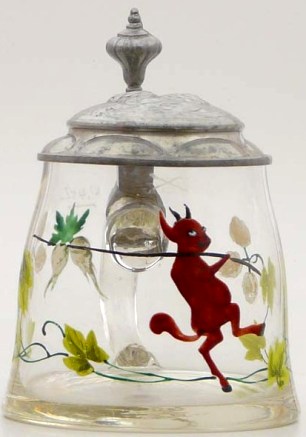
Radish (cont.) – Shown: .5 liter enameled blown glass, Circa 1910. Scene interp: Radishes with beer (hops) are the “devil’s food.” Unknown maker. Art Deco period.
.
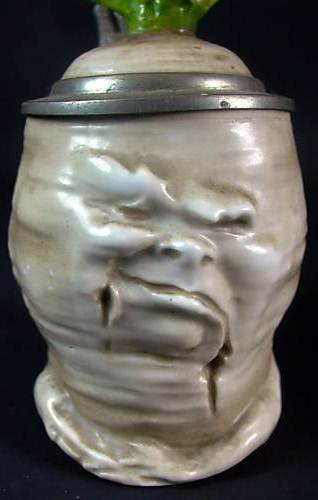
“SAD RADISH” – Porzellan, Schierholz, Ca. 1900.
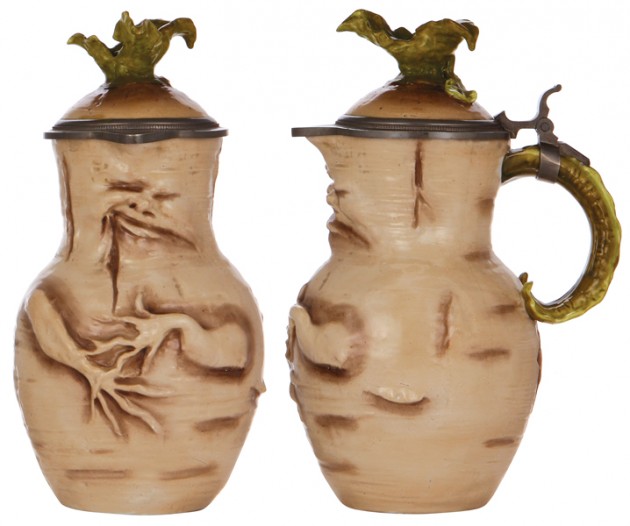
“Sad Radish” – The server, a 2 liter. Porcelain, by Schierholz.
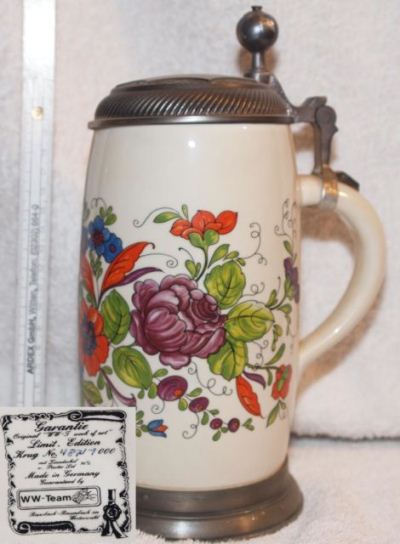
Ransbach-Baumbach= New stein making firm located in the Westerwald. Maker of some of the nicer limited editions steins as shown ▲. 9.2 inches tall.
Rare – Ha ! What a joke, on 7 -12 -2010, I looked up “Rare Stein ” on eBay. I got 397 hits, and 5 more under the spelling: “stien.” The one pictured above, even though described as being from the 1950’s was listed as being “Rare.”
The major USA stein auctioneer’s description of what is “Rare” is laughable too, which is why Mr. Paratore and I came up with a somewhat workable “Rarity Scale” = http://www.steveonsteins.com/rarity-scale-for-beer-steins
Let the buyer beware!! (Caveat emptor!) — And as we beer steiners say jokingly here in Virginia: “The emperor eats caviar!”
Rastal – German stein maker located in Hohr-Grenshausen. Still in production today. They made a lot of SCI steins when Werner Sahm, the owner, was alive and a SCI member. Shown left: This is one of their glass steins made for SCI.
Shown right: In the 1980’s (I believe) Rastal was also promoting some limited edition reproduction .800 silver steins, made by another (unknown to me) firm. And they are also well known for their recent production of the “Official Oktoberfest Bier Stein / Mug.
![RASTALS STEINS - PHOTOS FOR GK [1] 002](http://www.steveonsteins.com/wp-content/uploads/2010/10/RASTALS-STEINS-PHOTOS-FOR-GK-1-002-505x630.jpg)
.
![RASTAL STEINS - PHOTOS FOR GK [1] 001](http://www.steveonsteins.com/wp-content/uploads/2010/10/RASTAL-STEINS-PHOTOS-FOR-GK-1-0011-534x630.jpg)
See: http://www.steinmarks.co.uk/pages/pv.asp?p=stein1
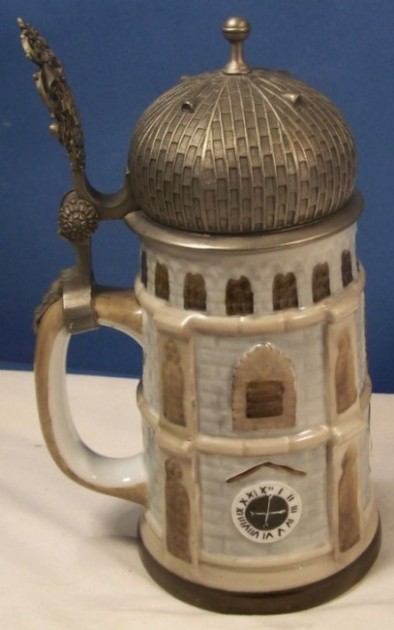
In the 1980’s Rastal also got involved in making reproductions of older collectable steins. This is their Ca. late 1700’s Westerwald model. Nicely done, but not quite as appealing as the older ones think several of us old timers.
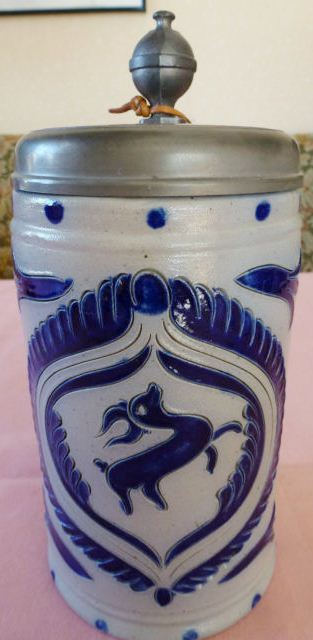
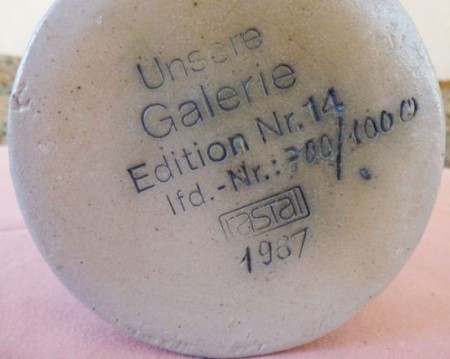
CR- Ratelbeck, WILHELM Design [PJ]. Jugendstil Bierkrug
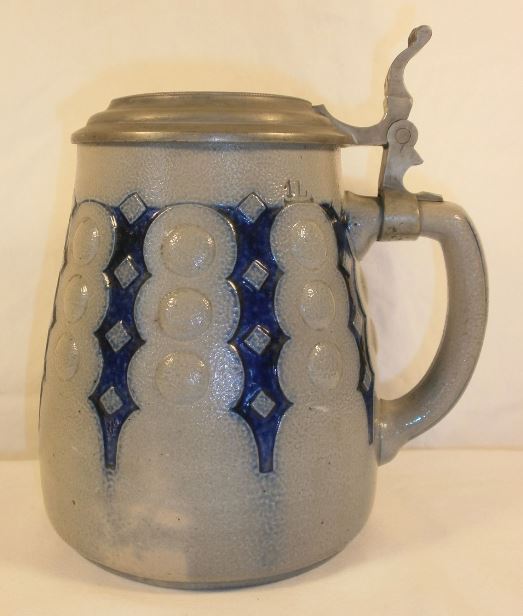
“Rattenfangen” or “The Pied Piper”- Shown: Thewalt’s 1/8th liter kinder mug version.
Also see: http://www.steveonsteins.com/some-german-fairy-tales-on-kinders-wrk-draft-stdtd-11-27
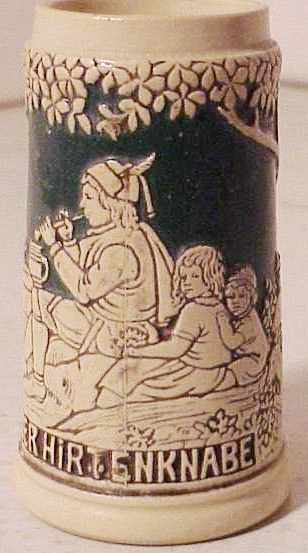
Rattenfanger stadt – The old own within Hamelin, Germany; famous for the Fairy Tale: “Rattenfangen” or “The Pied Piper.”
▼ .5 liter pottery PUG. An Army unit was stationed there and this stein was made for a member. Unusual.
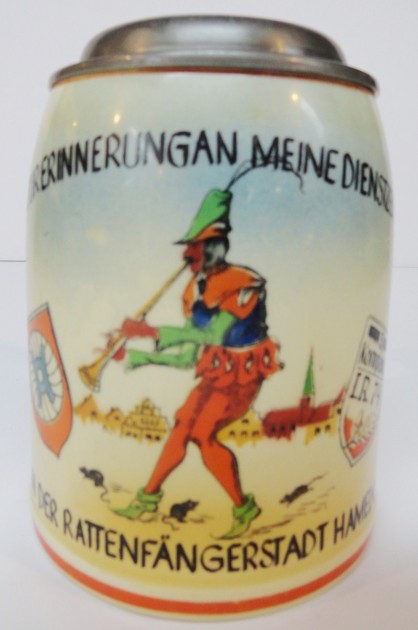
▼ Another pottery kinder mug. Ca. 1900.
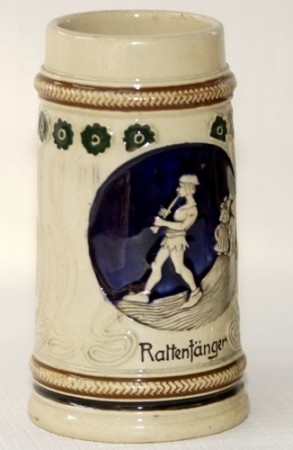
Ratzsch, Karl – Owner of a large German bar in Milwaukee in the early and mid 1900’s, noted for their collection of glass beer vessels (ROEMERS) on display. Their ads said; “Most interesting collection of old glassware, steins and other antiques.” What a great display.

Three porcelain steins, 2.5L, hand painted, all marked Rauenstein, floral & bird,two, .3L floral & bird, inlaid lid. [tsaco]
Rauenstein porcelain steins – (Friedrich Christian Greiner & Söhne) – Makers of very nice moderately priced o]old porcelain wares of all types located in Thuringia. For the firm’s extensive history see: http://www.steinmarks.co.uk/pages/pv.asp?p=stein207
“Thuringia is actually a region of Germany and not a maker. In this region there were so many porcelain makers by the end of the 18th century that they are now known as Thuringia porcelain. Some of the more important makers were Gotha, Wallendorf, Limbach, Volkstedt, Rauenstein, Kloster Veilsdorf plus many others.
Three people have been credited for getting it all started in this region: Georg Heinrich Macheleid, Johann Gotthelf Greiner and Johann Wolfgang Hamann.
The Greiner family was no doubt the most influential in making the Thuringia porcelain makers well known today. They had their hands in almost all the factories of this region around that time. Most of the makers are not around anymore today. Wallendorf and Volkstedt being the exceptions. The porcelain of this region, while not necessarily as good in quality as the more well known makers like KPM and Meissen, have a charm missing in some of the bigger makers. Part of the reason being that this porcelain was not made for the kings and high society but for the middle class. This charm is what makes them very collectible. 18th century Thuringia porcelain is very rare now and extremely hard to find.? QUOTED FROM “Antique Porcelain and Fine Arts,” @ http://www.porcelainbiz.com/thuringia.htm
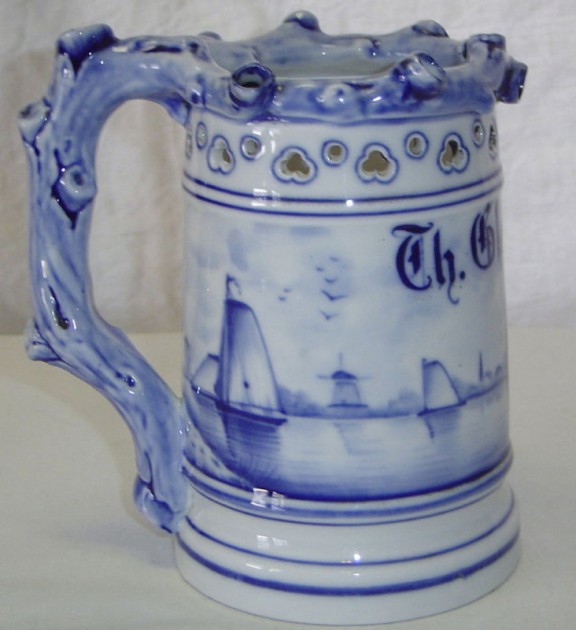
Raupenhelm finial
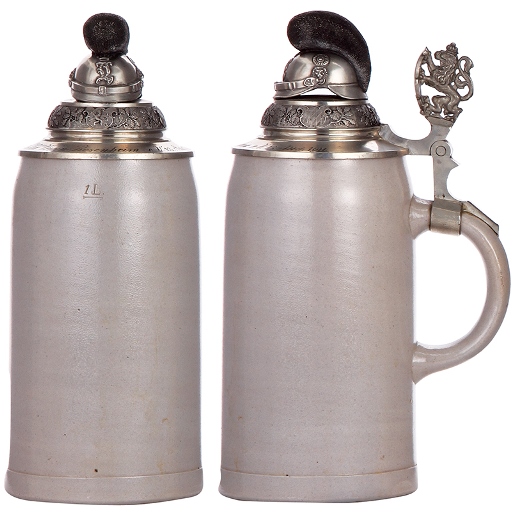

Red Cross steins – (Reservist’s) – (Another SCI misnomer) – Steins that were made for Sanitats (Medical Corpsmen) in the Imperial German or Bavarian Army. The medics were only using the symbol. They had no relation ship with the Red Cross Organization which started in the USA. [JS]
![RED CROSS - Regimental stein, .5L, 9.5 ht., porcelain, Erinnerung a.d. Garnison Erlangen, 1904 - 1906, two side scenes [medical & barber], lion thumblift, named to Sanitäts Gefreiter Alfons Schmidt,](http://www.steveonsteins.com/wp-content/uploads/2010/10/RED-CROSS-Regimental-stein-.5L-9.5-ht.-porcelain-Erinnerung-a.d.-Garnison-Erlangen-1904-1906-two-side-scenes-medical-barber-lion-thumblift-named-to-Sanitäts-Gefreiter-Alfons-Schmidt-630x393.jpg)
[tsaco]
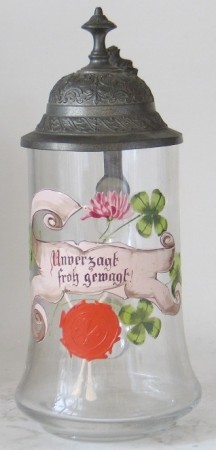
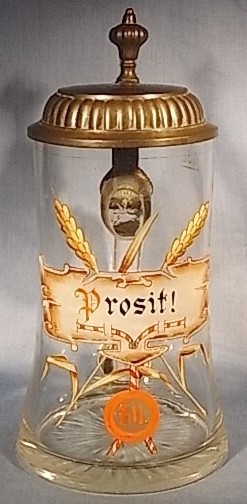
Red seal steins and other vessels- I am pretty certain many of these were all made by Theresienthal in and about the years of 1910-14. No documentation available yet! There is a SCI member’s collection of these “Red seals” in Ohio, and all together with the beakers, steins, roemers, and other vessels, it is quite impressive!
.

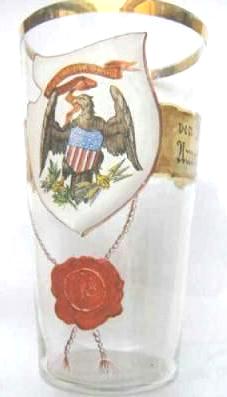
Red Seal, German blown glass beaker. 9 inches tall.
Reducer – A small concave cutting into the side of a glass stein that usually shows an engraved scene at 180 degrees away in a much smaller perspective. Shown: Reducers abound on this cut ruby stained glass stein, and the basic design shows the opposite side’s the reducers themselves, which is apparent by looking through one on the left.

An all ruby glass poal , unsigned as most and provably by the Egermann workshop, This work of art one comes with a “reducer” on the other side.; which as its name implies reduces the image on the opposite side when looking through it. [FWTD] Editors note: If I can get my camera to cooperate I’ll try to get a shot of the deer through the reducer (sometime in the near (?) future.=
Reed and Barton – An American firm that made steins and other drinking vessels in silver, silver plate and pewter. They also imported steins such as the one shown, a pewter “roerken” made by Santesson in Stockholm.
See: http://www.steveonsteins.com/roerkenville-northern-germany-a-very-expensive-town-to-live-in-draft-4-10-11
For company info see: http://www.steinmarks.co.uk/pages/pv.asp?p=stein1
.

Above marked: Reed and Barton, “Mayor’s Cup” with engraved American Eagle Shield. “Prize drill Co.H,8th Infantry, MVM (Mass, Volunteer Militia) Won, Cpl. W.J.Hoppe, Feb.14,1907. No.0240S. 12-3.8 inches.
.
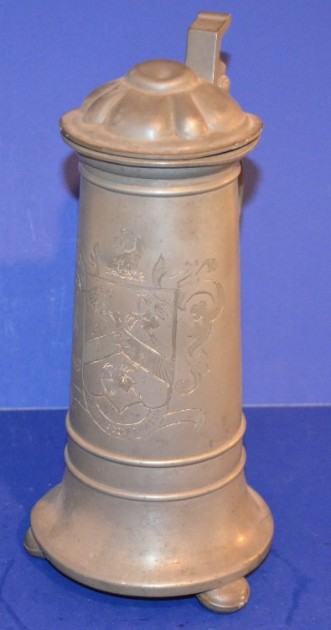
A more typical “American style” tankard by R & B. 10 3/4 inches.
Regensburg stein – A“misnomer” that’s been around a long time and just will not go away! It pertains to the style of stein shown to the left. Most of these all grey, tan or brown stoneware steins were made in the Westerwald around 1860-1880. There were some stein making firms in Regensburg, that imported Westerwald clay. The nickname for all these mono toned steins to collectors on the East Coast is “Mud Steins. For more on Mud Steins, see, (IF THIS WEB PAGE IS UP = mid to late 2013?):The Un-official Catalog of “Mud” (German: “Model”) steins.
Regensburg stein (authentic, not a Westerwald called that.) – Shown to the left is a real Regenburg saltglazed server, made by Fritz Thenn firm in Regensburg, very close to Munich. These potters used clay imported from the Westerwald and are often confused for vessels coming from that area. Most of these steins and servers are noted for the heavy outlined relief work and the small applied decorations (lion’s faces, etc.) Many of these come with armorials (not Crests!) A lot of them are dated 1588, for a reason unknown to me.
For much more info please click on the third and fourth articles = HR steins .; and Fritz Thenn Regensburg
@ = http://www.thepatriotexchange.com/pss/infolnk2.htm
See also: http://www.steveonsteins.com/the-beauty-of-the-historismus-period19th-century-wine-jugs-from-the-westerwald-and-regensberg-including-the-ring-jugs-awpd-12-29-12
“Regimental” stein – Another misnomer that’s been around a long time and just will not go away! The proper name for these steins is “Reservists” as the German soldiers bought them shortly before going into the reserves. The term Regimental also can not apply to all these steins as there were special units, details, detachments, companies and regiments. The most glaring misnomer comes with the men whose steins who were assigned to Naval units and ships, being called ‘Regimentals.’
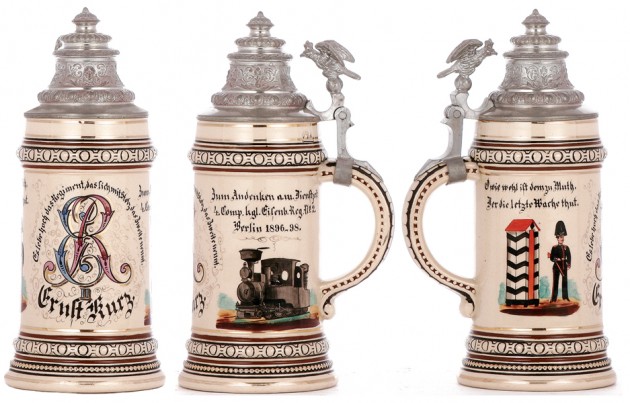
Shown: An example of the older style reservist’s (regimental steins.) For an Eisenbahn [Railroad unit] in Berlin, 1896 -98. All hand enameled work. No decals, which is why I actually like these better than the extra large ones made about 1912-14. but most other collectors don’t.
There are several variables that add to the collectablity or non-collectablity of these steins.
VERY BRIEFLY THEY ARE :
[1] dates of production – the younger ones are taller and more collectable.
[2] material of stein – pottery, pottery relief, porcelain, pewter, silver.
[3] unit designation – this is really complicated – Some units like the Bavarian Infantry steins are found all the time. All the Prussian guard units are usually the most collectable.
[4] special rank designations – one year volunteers, buglers drummers, medics, sergeants.
[5] other special unit designations – double units, various military schools, etc.
[6] extra features – such as intact stanhopes, helmet or crown lids, original guard stars hanging, and scarce side scenes.
[7] and of course condition is very very important!!
Also see web page = http://www.steveonsteins.com/reservists-regimental-reproductions
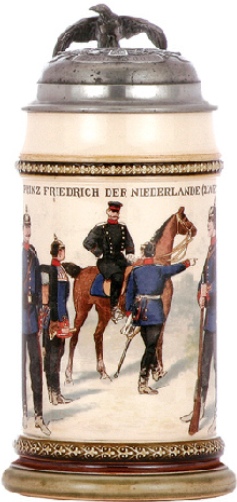
Shown: A V & B Mettlach “Regimental” stein, This PUG series is actually closer to being a “Regimental” than the steins that are called such. Each is dedicated to one unit and shows it’s uniforms. These could have been bought at any time; some have the soldiers names on them, most do not.
For more info, see: http://www.beerstein.net/articles/s8109.htm
Regimental steins, USA troops – see “Cold war steins.”
Rehbock (Germ) – Roebuck (Eng.) A tiny deer found in Germany and the Alps regions. A subject on lots of illustations and engraved cuttings on beer steins.
Reich’s eagle – The empires eagle = The Imperial German eagle (adler), sometimes shown with the coat of arms of the various German states on it’s wings or as shown on the sides of this Kayserzinn example. Shown: #4095. A server with the Imperial and State arms of Germany -13 inches.
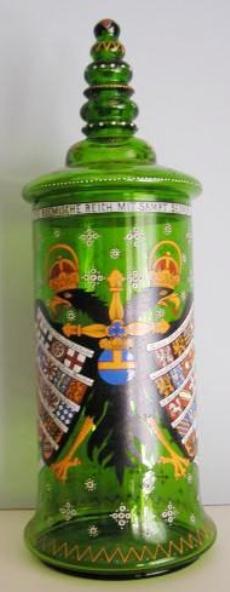
Reichsadlerhumpen, or Imperial Eagle beakers – Large beakers painted in enamels with elaborate armorials or other motifs, were made from the sixteenth century through to the eighteenth century by various glass houses within the Holy Roman Empire. They were much collected in the nineteenth century and frequently reproduced, as is the one shown. Above ▲: Eggerman’s [?] Ca. 1880-90. Below ▼: By Fritx Heckert Ca, 1890.
.
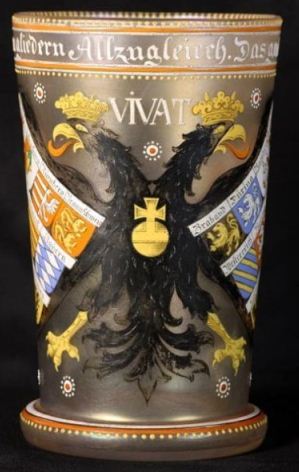
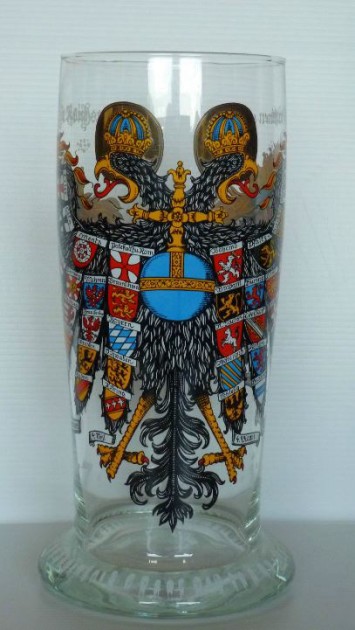
These Humpen are still being made and well sold. This version was bought in Germany in 1985.
Reichzinn- Pewter stein makers, location unknown to me. Made what I would call half assed stuff (steins). See: http://www.steinmarks.co.uk/pages/pv.asp?p=stein1
Rein Zinn – A stamped mark, usually found on the underside of a pewter lid, which means simply “Pure” / “Fine” pewter.

Reinemann, J – A Stein distributor in Munich; stamped his name on the pewter tang and also on bottom of the stein, which were mostly pottery ones.
Shown: “Hanswurst,” A .25L, stoneware, marked Reinemann, was designed by F. Ringer.
See: http://www.steinmarks.co.uk/pages/pv.asp?p=stein1
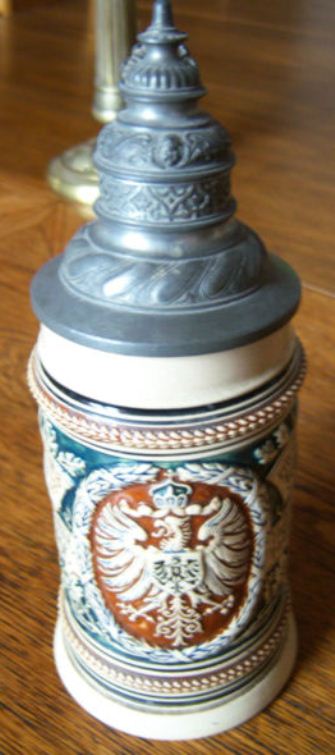
Reinhold Merkelbach – A well respected stein maker. Used a six sided star for it’s older pieces. Shown: A .5liter pottery relief. More than likely a 25 year anniversary stein, celebrating the winning of the Franco-Prussian War of 1870-71 (See Franco-Prussian War steins in this site’s Compendium.
See factory info at: http://www.steinmarks.co.uk/pages/pv.asp?p=stein169
.
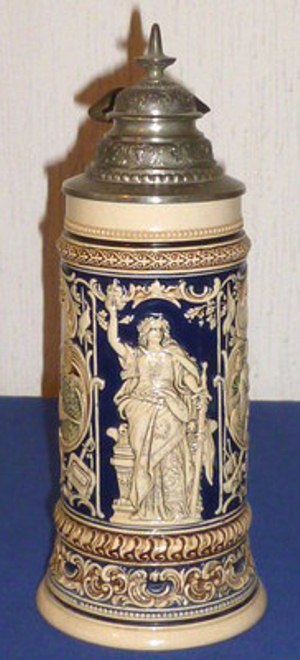
A nicer photo showing the quality of older steins from this firm. “Germania” is the body’s subject.
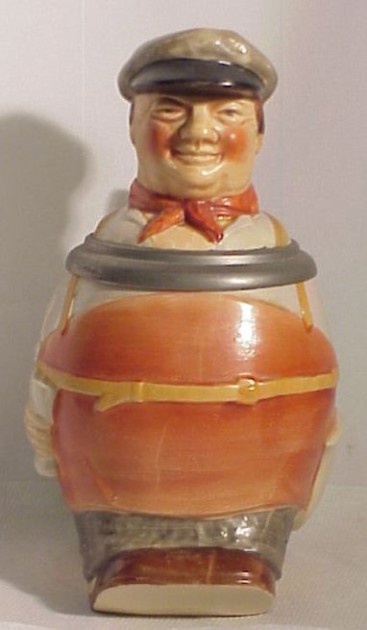
A newer character stein by R /M.
![RELIEF STONEWARE [Q] - UNUSUAL Antiker Beer Stein Bierkrug Säcularfest Würzburg 1882](http://www.steveonsteins.com/wp-content/uploads/2010/10/RELIEF-STONEWARE-Q-UNUSUAL-Antiker-Beer-Stein-Bierkrug-Säcularfest-Würzburg-1882.jpg)
Applied relief Coat of Arms and scroll. Säcularfest Würzburg 1882
Relief — [1] Found on pottery and porcelain and very few stoneware steins; when figures and sayings, etc. are [a] attached to the body by means of wet “slip” and then fired, or [b] relief work. that comes out of a mold and is usually hand finished. Also called embossing in English. [2] With metal steins this is usually done by pounding on the back side of the plate before assembly, and is not called relief but “Repoussé.” [3] Going to the toilet, especially after drinking lots of good German beer!
Somebody’s “relief” – one way or another!
Religious / fellowship / friendship steins – Mostly found on Ruby or yellow stained, cut-to-clear glass steins and beakers from the 1860’s to 1880’s. There are several major designs that are followed such as the cornucopia, cross, heart, etc
SEE : Fellowship symbols on ruby cut-to-clear glass drinking vessels: http://www.steveonsteins.com/ruby-cut-to-clear-fellowship-symbols-1
Remy, J. W. – Another prolific pottery stein maker. See: http://www.steinmarks.co.uk/pages/pv.asp?p=stein1
Remy, P .W.–– Much smaller stein maker. See details: http://www.steinmarks.co.uk/pages/pv.asp?p=stein1
Renaissance (and very late medieval) beer / water / wine mugs – Shown above ▲: A hand thrown stoneware drinking mug typical of those made in Germany around Siegberg, Koln, (Cologne) and in the Netherlands in the late 1400 and 1500’s. The Pottery mugs that were used for local drinking are rare to find intact (not restored, most looking at least like the mug above.
However some mugs, and drinking bowls were made in bronze / called brass at th time and used by the upper classes for everyday use. They were still expensive. Remember that copper was an almost semi-precious metal back the (bronze being an alloy made of copper and tin .)
Below are shown a couple of Renaissance bronze drinking mugs, etc
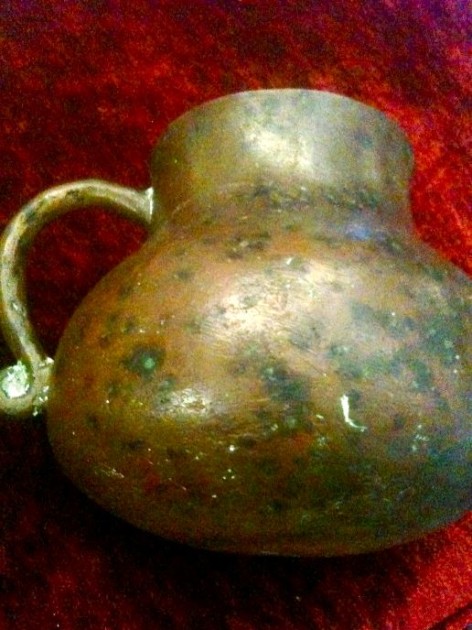
.
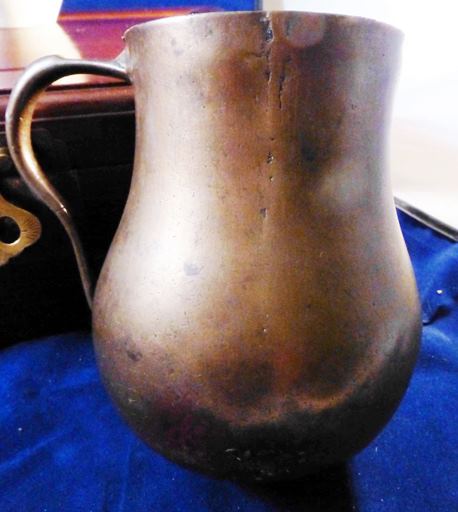
![SOS - A - Renaissance BRONZE DOUBLE HANDLED JUG PASS CUP [Q] handle is typical forr the period](http://www.steveonsteins.com/wp-content/uploads/2010/10/SOS-A-Renaissance-BRONZE-DOUBLE-HANDLED-JUG-PASS-CUP-Q-handle-is-typical-forr-the-period-630x442.jpg)
[FWTD]
The reader will please compare the pig tail handle finial on this pass cup / drinking bowl with the example shown two above.
There is a small debate at Smith’s Museum and tavern on whether or not this could be a pass cup – I am of the opinion that while this piece might not have been designed specifically for that use [!] , as the lip is larger than it need be, it certainly could and probably was used for that. The Scandinavians had their drinking bowls of painted wood with horses and dragons on the sides as handles.
The English had what they called a “caudle” cup . Caudle being a warmed up wine drink mixes with (it changed throughout time A recipe from the late 14th century has more ingredients and more details on the cooking procedure: mix breadcrumbs, wine, sugar or honey, and saffron, bring to a boil, then thicken with egg yolks, and sprinkle with salt, sugar, and ginger.
The handle are well balanced for a quick sip of ale to the thirsty visitor and then passed around the table.! [FWTD} To see more on “Pass Cups” See: http://www.steveonsteins.com/pass-cups-a-short-history-new-12-26-10
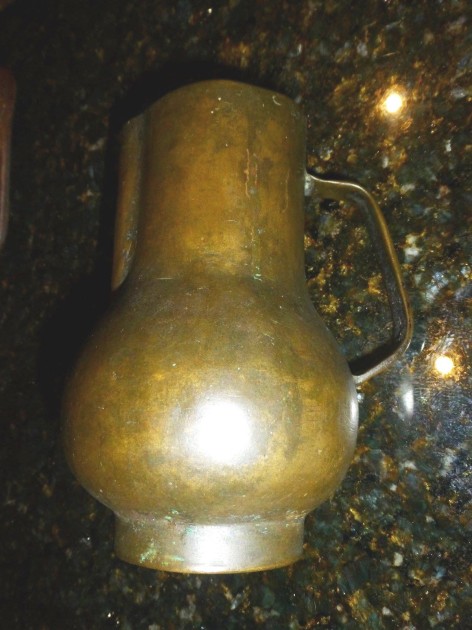
An individual’s small Bronze wine server of the Renaissance period = HOWEVER THIS ONE IS A FAKE – Hard to tell until you hold it. It had be brushed with an acid to make the surface look like natural oxidation. But it will not shine up as the real bronze ones do. Perhaps English made. Ca. post 1960’s; when reproductions of almost everything antique were rampant ? It didn’t cost much so I kept it to use as a lecture learning tool. [FWTD}
.
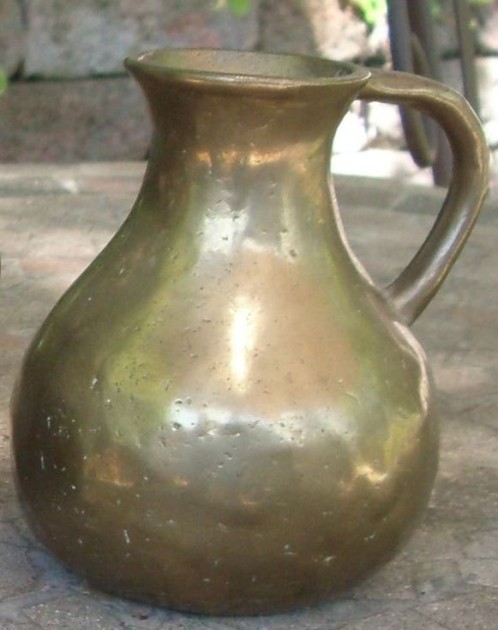
A bronze “towards the end of the renaissance” small bronze wine wine pitcher. The base is good and flat on this example the others above are somewhat rounded. [FWTD ]
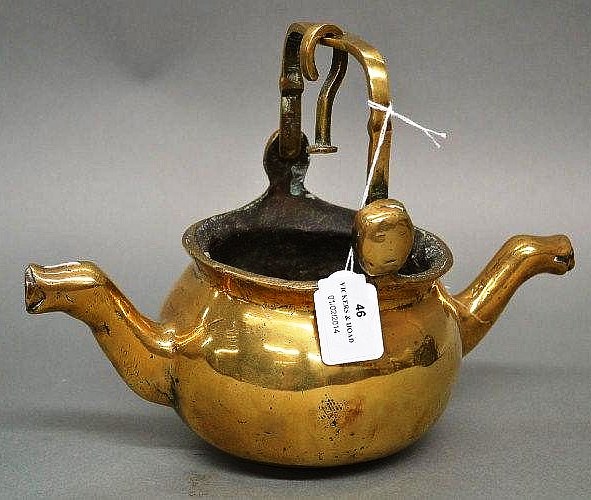
Called in German a “water kettle” these hanging objects were certainly used to pour other liquids such as wine; sand given how back the water supply was in European the weather a drink of wine from one of these would be a welcome treat to a guest. These these do go back to medieval times, say the 1300’s up to through the late 1600’s., and early 1700’s. Most being classified as being from the 1400’s. Made in northern Europe, and not just in Germany [FWTD] There are cheap reproduction being made and sold of course. Shown below: No wear or stained coloration on the inside . The heads on the sides are in terrible relief and no eyes are engraved on the dragon spouts. see ▼ ▼.
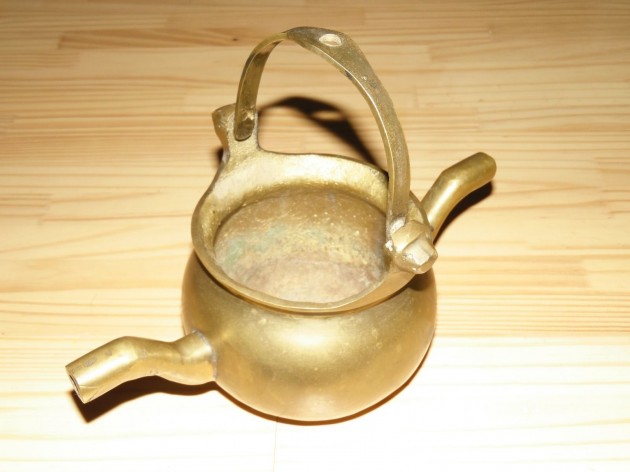
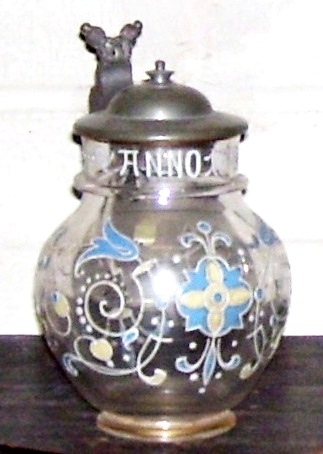
Renaissance “historismus” glass steins – Most all of these are dated in the late 1500’s to early 1600’s all made in the 1870-80’s, so be careful out there. But a collector friend of mine found an original one in a New England auction a few years back for less than $200! Shown above: .5 liter, Dated 1648.* Unknown maker.
For photos of more of these and authentic ones see: http://www.steveonsteins.com/renaissance-blown-and-enameled-glass-reproductions
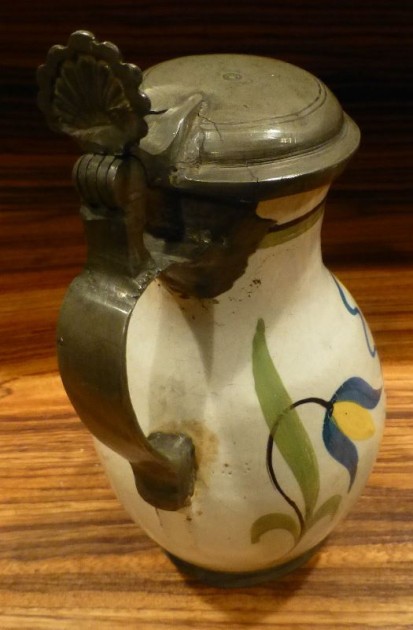
Repaired steins versus restored steins- The two words are often used incorrectly to describe a stein’s condition , especially on the internet sales sites. “Repaired” means :To make it functional to use.
“Restored” means to have brought the piece back to as close to its original appearance as possible and functional to use. . Shown above: ▲ a repaired stein.
Replaced lids – A very definite problem for the new (and some advanced) collectors. The real pewter-smiths from stein companies in Germany for years could and have re-lidded old steins that had broken off lids. There also have been several stein collectors here in the States that have done this type of work. Since I have joined SCI in 1971 I know of five major stein “re-lidders;” four of which are deceased now. Some of these have knowingly put the wrong date / wrong type of lids on mugs to convert them, and sometimes the present owners request such be done. Mr. Harr who is a 100% trustworthy “lid repair” pewter-smith will not do that, and I commend him for that. See My Links page. Shown above : A beautiful Bohemian cased glass mug with a hand painted scene, Circa 1860, that has had the wrong [1] type AND [2] date AND [3] incorrect sized (ill fitting) lid placed on it in its past! To me that lid looks like it originally graced a V & B Mettlach PUG stein (#1526.), and would be Circa 1890.
.
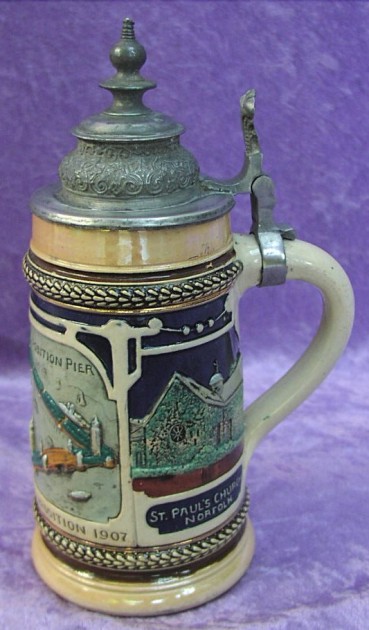
Above ▲ – there are two ways too tell this lid was replaced: [1] The hinge pin is closed, this stopped being done somewhere around 1865, while the stein is from about 1890 – 1910 [2] observe the shiney handle strap versus the oxidation on the shank [the vertical support] it has been replaced; however as there are chemical that can be applied to make pewter repairs darker , always look for differences in the width of the handle strap and for any scratches which might indicate the use of pliers, or such.
Above ▲ just the opposite , this one has a newer lid – as one can plainly see tthe hinge pin pin’s circle which came in about 1865 to 1890.
Also see “Married” in this Compendium.
Repoussé – -A method of making patterns or pictures on metal, in relief, by pushing out the surface of the metal from behind. Also wrongly called ‘relief.’
Reproduction steins, general
See in this compendium:
[1] King Limitaet (series) – New (2000) limited editions. Remakes of some of the nicer antique pottery steins. {Very good quality.]
[2] König Brewery, Germany – Series of reproductions of older steins [also of good quality
[3] Heckert — glass drinking vessels repros
]4] For regimental and occupational reproductions – see full page articles on this web site; in “subject index” listing on right side of the opening page entitled:
RESERVIST’S (REGIMENTAL) AND OCCUPATIONAL REPRODUCTION BEER STEINS
Reservist steins, Austrian – See: http://www.beerstein.net/articles/bsj-3c.htm
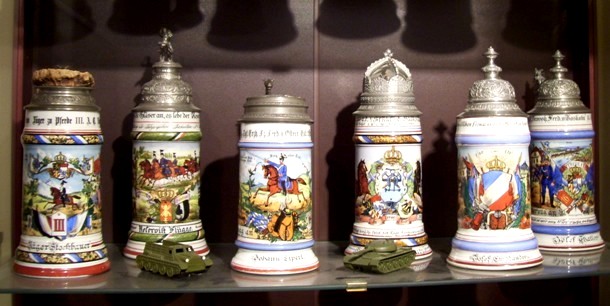
Reservist’s steins German – [Called Regimentals – see above] This is the correct name for German beer steins for a military service unit member mustering out, and some special presentations. These were made of porcelain (about 90%), pottery (about 9%) and pewter (about less than 1%.) The custom of buying a stein to celebrate ones service almost stopped completely after World War 1 ended. See ‘Regimental stein’ just above. Shown: Some different reservist steins showing differences in lids and body designs. These are all of porcelain but they did make plenty of them in pottery, and a very few in pewter too. [FWTD]
There are several variables that add to the collectablity or non-collectablity of these steins.
VERY BRIEFLY THEY ARE :
[1] dates of production – the ounger ones are taller and more collectable.
[2] material of stein – pottery, pottery relief, porcelain, pewter, silver.
[3] unit designation – this is really complicated – Some units like the Bavarian Infantry steins are found all the time. All the Ptussian guard units are usually the most collectable.
[4] special rank designations – one year volunteers, buglers drummers, medics, sergeants.
[5] other special unit designations – double units, various military schools, etc.
[6] extra features – such as intact stanhopes, helmet or crown lids, original guard stars hanging, and scarce side scenes.
[7] and of course condition is very very important!!
Also see web page(s) = http://www.steveonsteins.com/reservists-regimental-reproductions
.
Reservist’s steins, pewter – Unusual representations and when found, most of these come from Bavarian units. [L]: 19TH Bavarian Inft. Regt. [R]: 20th Bavarian Inf. Regt. [TSACO]
Reservist’s steins – See: “Reservist (Regimental) Reproductions,” [several pages] this web site: http://www.steveonsteins.com/reservists-regimental-reproductions
Reval 1780-1792 – City or town of major fayence stein production. For more info, see: http://www.thepatriotexchange.com/pss/hisfai.htm
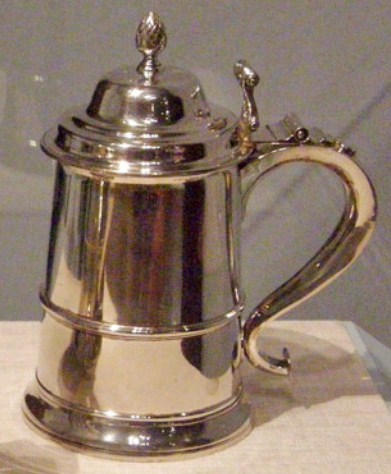
Revere, Paul – A famous American silver smith, amongst other attributes maker of silver tankards in the 1799’s. This particular style tankard (probably the most famous in the USA), has been copied many times in both silver and silver plate.
Shown above: An original located in the Milwaukee Art Museum.

A “limited edition” Sterling silver replica of a Revere silver stein at the Winterthur Museum in Delaware. When these came out they were so cheap I bought one for all three of my grand children for their 18th birthday. This one sold, tarnished as shown, for $1625 in Nov of 2011.
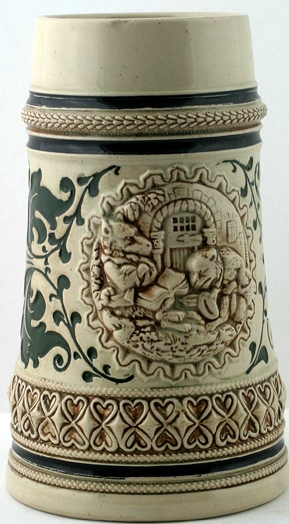
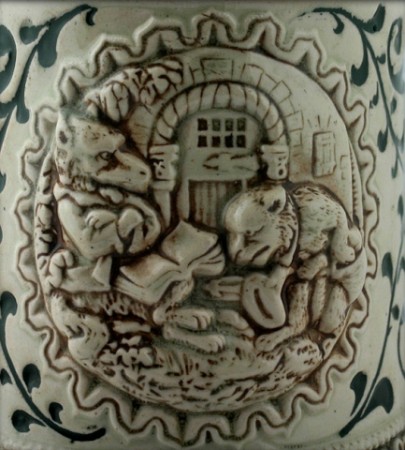
Reynard the Fox – A medieval animal character whose antics are depicted on many German steins. Shown: A 1 liter pottery relief stein showing a scene from one of the many stories about Reynard, the Fox.
Theories about the origin of the name Reynard are: [1] From the Germanic man’s name Reginhard, which came from ‘regin’ = “the divine powers of the old Germanic religion” and “hard”: “made hard by the gods”, but with the disuse of the old Germanic religion was later likely interpreted as “rain-hard” meaning “staying steady under a rain of blows from weapons in battle” or similar.
[2] From the Germanic man’s name Reginhard (later condensed to Reinhard), which comes from ‘regin’ = “counsel” and ‘harti’ = “strong”, denoting someone who is wise, clever, or resourceful.
The traditional French word for “fox” was ‘goupil’ from Latin vulpecula. However, mentioning the fox was considered bad luck among farmers. Because of the popularity of the Reynard stories, renard was often used as a euphemism, so that today renard is the standard French word for “fox” and goupil is now dialectal or archaic.
In medieval European folklore and literature: The figure of Reynard (der Fuchs) is thought to have originated in Alsace-Lorraine folklore from where it spread to France, the Low Countries, and Germany.
Reynard appears first in the medieval Latin poem Ysengrimus, a long Latin mock-epic written ca. 1148-1153 by the poet Nivardus in Ghent, that collects a great store of Reynard’s adventures. He also puts in an early appearance in a number of Latin sequences by the preacher Odo of Cheriton. Both of these early sources seem to draw on a pre-existing store of popular culture featuring the character.
An extensive treatment of the character is the Old French Le Roman de Renart written by Pierre de Saint-Cloud around 1170, which sets the typical setting. Reynard has been summoned to the court of king Noble, or Leo, the Lion, to answer charges brought against him by Isengrim the Wolf. Other anthropomorphic animals, including Bruin the Bear, Baldwin the Ass, Tibert (Tybalt) the Cat, all attempt one stratagem or another. The stories typically involve satire whose usual butts are the aristocracy and the clergy, making Reynard a peasant-hero character.
The story of the preaching fox found in the Reynard literature was used in church art by the Catholic Church as propaganda against the Lollards. Reynard’s principal castle, Maupertuis, is available to him whenever he needs to hide away from his enemies.
Some of the tales feature Reynard’s funeral, where his enemies gather to deliver maudlin elegies full of insincere piety, and which feature Reynard’s posthumous revenge. Reynard’s wife Hermeline appears in the stories, but plays little active role, although in some versions she remarries when Reynard is thought dead, thereby becoming one of the people he plans revenge upon. Isengrim is Reynard’s most frequent antagonist and foil, and generally ends up outwitted, though he occasionally gets revenge.
In 1174, the first branch or chapter of the Roman de Renart appears, written by Pierre de St. Cloud (though in all French editions it is designated as Branch II). Pierre wrote a sequel in 1179 (called Branch I) but between that date and after many French authors composed their own adventures for Renart li goupil (the fox).
A 13th-century Middle Dutch version of the story (Van den vos Reynaerde, About Reynard the Fox), is also made up of rhymed verses (the same AA BB scheme). Like Pierre, very little is known of the author, Willem, other than the description by the copyist in the first sentences:
Geoffrey Chaucer used Reynard material in the Canterbury Tales; in “The Nun’s Priest’s Tale”,
In 1481 William Caxton printed The Historie of Reynart the Foxe, which was translated from a Middle Dutch version of the fables.[1] Also in the 1480s, the Scottish poet Robert Henryson devised a highly sophisticated development of Reynardian material as part of his Morall Fabillis in the sections known as The Talking of the Tod. Hans van Ghetelen, a printer of Incunabula in Lübeck printed an early German version called Reinke de Vos in 1498. It was translated to Latin and other languages, which made the tale popular across Europe.
Modern treatment = Rénert the Fox = Rénert the Fox was published in 1872 by Michel Rodange, a Luxembourgish author. An epic satirical work, an adaptation of the traditional Dutch fox epic to a setting in Luxembourg, it is known for its insightful analysis of the unique characteristics of the people of Luxembourg, using regional and sub-regional dialects to depict the fox and his companions.
There is also the text “Reinhard Fuchs” by Heinrich der Glïchezäre; WHOSE BOOK I THINK IS THE BASIS FOR MOST OF THE GERMAN “FAIRY TALES” ABOUT HIM AND ARE DEPICTED SCENES ON OUR BEER STEINS.
Also see: Fuchs in this site’s Compendium.
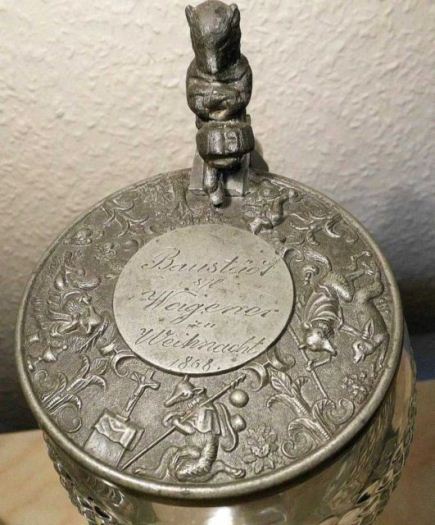
Lid with scenes from Reynard’s life stories, also with him as a thumblift.
[END – SOK – 51- 4D]
 We never really grow up, we only learn how to act in public.
We never really grow up, we only learn how to act in public.

